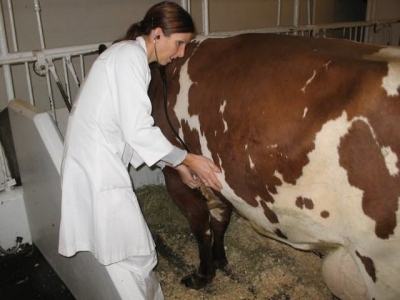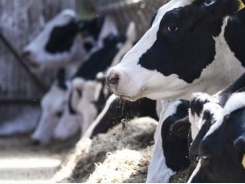We carry viruses from barn to barn

Pneumonia is a mounting problem in barns.
Veterinarian Thea Blystad Klem at NMBU studies pneumonia in barns. (Photo: Faisal Suhel)
Postdoc Thea Blystad Klem at the Norwegian University of Life Sciences (NMBU) researches the sources of bovine respiratory syncytial virus (BRSV) contagion.
This virus thrives in the lungs and can have dire consequences. The respiratory disease is often fatal for livestock.
The researcher has conducted a pilot project on two coughing, runny-nosed cows. She found the virus present in the cows’ noses for 12 days.
“This is much longer than other studies have shown. Farmers, vets and people on neighbouring farms need to take heed,” says Klem.
Hygiene is obviously a factor but too little is known about the main ways the infection is spread.
Barns can not be hermetically sealed
However, Klem realises it isn’t feasible to hermetically seal barns. Even if people who visit barns are careful about changing clothes and washing their hands on the way out, the virus can cling to the soles of their boots or perhaps hide beneath a wristwatch.
It would be unrealistic for farmers or veterinarians to shower down like nuclear power plant workers or disinfect all their clothing and equipment every time they step into a barn, points out Klem.

A feeble calf. Researchers infected this one with BRSV. It became so sick in its stall at NMBU that it could no longer stand. (Photo: Faisal Suhel)
“So the key idea is to find out where the greatest concentration of virus is so that we can be extra careful with that object,” she says.
In an attempt to find out where the virus can hitch a ride, she tested watches, boots and stethoscopes that vets used when visiting stricken animals. These experiments have not been fully analysed yet.
Sales of animals and their transfer from one herd to another is another source of contagion, especially when it comes to long-distance transmission of the BRSV.
“Once we learn how long a cow is potentially contagious we can issue clearer advice about how long farmers should wait before buying or selling cattle,” says Klem.
Translated by Glenn Ostling
Có thể bạn quan tâm
Phần mềm

Phối trộn thức ăn chăn nuôi

Pha dung dịch thủy canh

Định mức cho tôm ăn

Phối trộn phân bón NPK

Xác định tỷ lệ tôm sống

Chuyển đổi đơn vị phân bón

Xác định công suất sục khí

Chuyển đổi đơn vị tôm

Tính diện tích nhà kính

Tính thể tích ao hồ



 Grazing reed canarygrass may control invasive plant
Grazing reed canarygrass may control invasive plant  Calves aren’t being given enough milk
Calves aren’t being given enough milk